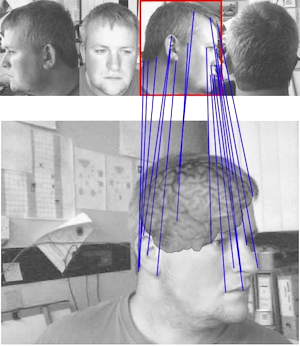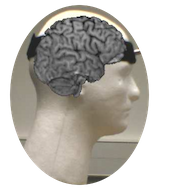Professor Nigel W. John FEG FLSW
Home Research About Contact
Utilising the Grid for Augmented Reality (2003-2008)

 This project investigated the use of Augmented Reality within a high performance computing environment, such as the computatonal Grid (Brodlie et al., 2005; Hughes & John, 2007). In particlular, the pose tracking and estimation tasks needed for registration were distributed to the Grid.
This project investigated the use of Augmented Reality within a high performance computing environment, such as the computatonal Grid (Brodlie et al., 2005; Hughes & John, 2007). In particlular, the pose tracking and estimation tasks needed for registration were distributed to the Grid.
 The test bed application used was Transcranial Magnetic Stimulation (TMS) (Hughes & John, 2006). This is a process in which electrical activity in the brain is influenced by a pulsed magnetic field. Common practice is to align an electromagnetic coil with points of interest identified on the surface of the brain, from an MRI scan of the subject. The coil can be tracked using optical sensors, enabling the targeting information to be calculated and displayed on a local workstation. Our hypothesis was that this procedure would be more effective with an augmented reality interface such as that depicted in the margin image.
The test bed application used was Transcranial Magnetic Stimulation (TMS) (Hughes & John, 2006). This is a process in which electrical activity in the brain is influenced by a pulsed magnetic field. Common practice is to align an electromagnetic coil with points of interest identified on the surface of the brain, from an MRI scan of the subject. The coil can be tracked using optical sensors, enabling the targeting information to be calculated and displayed on a local workstation. Our hypothesis was that this procedure would be more effective with an augmented reality interface such as that depicted in the margin image.
Hughes, C. J. (2008). Utilising the Grid for Augmented Reality. PhD Thesis, Bangor University. This project was undertaken by my PhD student Chris Hughes. It was funded by the EPSRC grant An Advanced Environment for Enabling Visual Supercomputing (the e-Viz Project), which was in collaboration with Manchester, Bangor, Swansea and Leeds Universities.
Chris is now a lecturer at Salford University.
Further Reading
- Brodlie, K., Brooke, J., Chen, M., Chisnall, D., Fewings, A., Hughes, C., … Roard, N. (2005). Visual supercomputing: technologies, applications and challenges. Computer Graphics Forum, 24(2), 217–245.
- Hughes, C. J., & John, N. W. (2007). A Flexible Approach to High Performance Visualization Enabled Augmented Reality. In Theory and Practice of Computer Graphics (pp. 181–186). Eurographics Association.
- Hughes, C. J., & John, N. W. (2006). A flexible infrastructure for delivering augmented reality enabled transcranial magnetic stimulation. Medicine Meets Virtual Reality 14: Accelerating Change in Healthcare: Next Medical Toolkit, 219.